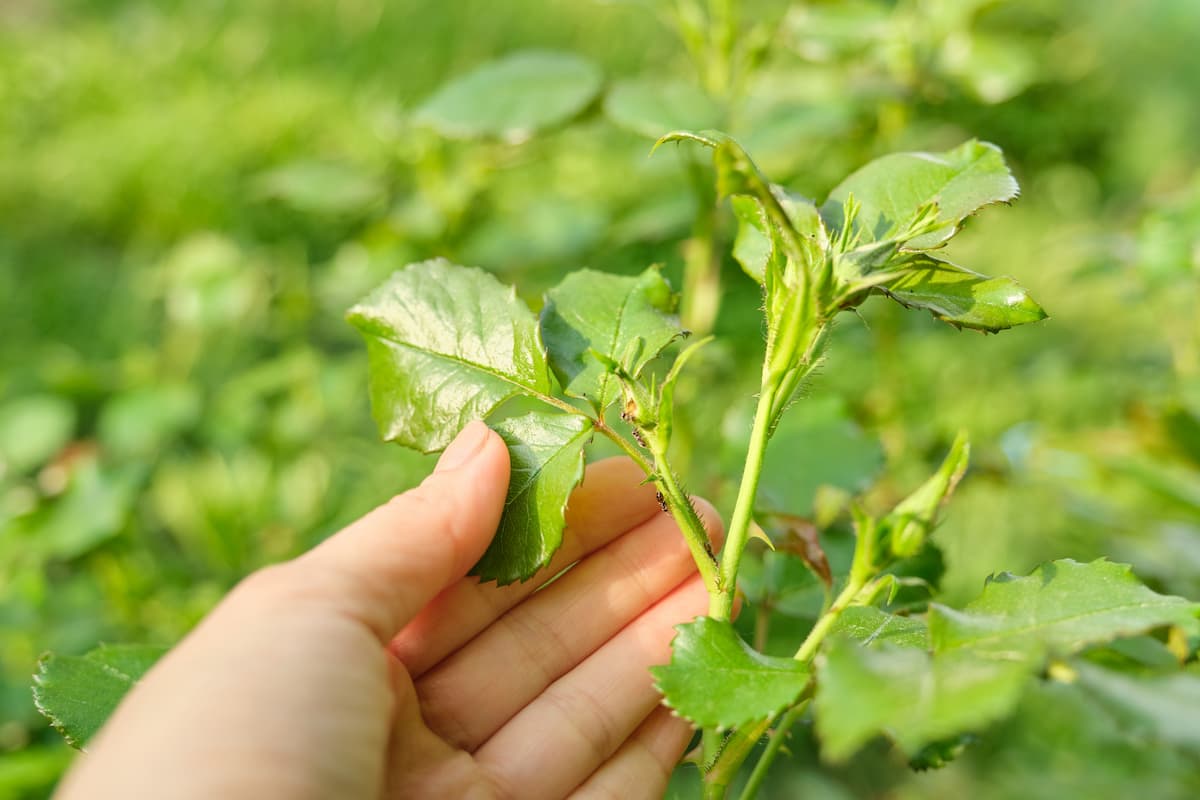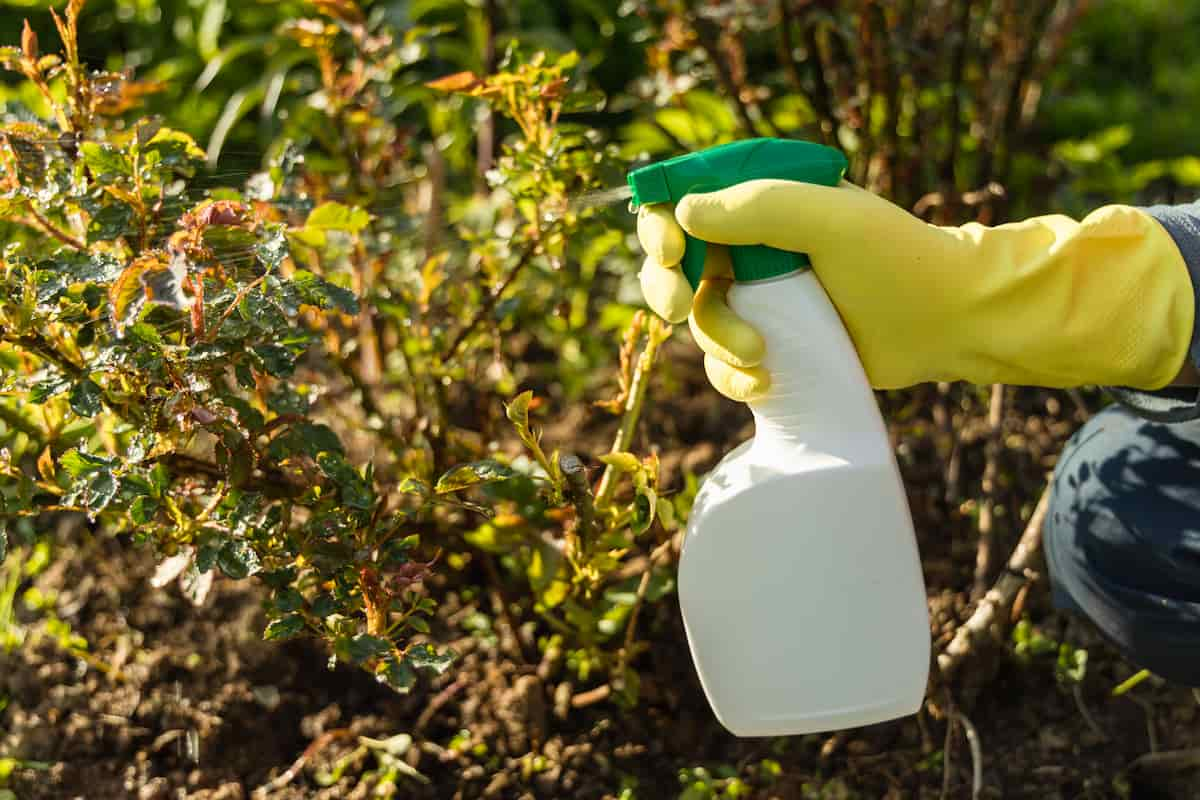The Rose Leaf Cutter Bee, Megachile anthracina, belonging to the Family Megachilidae of the Order Hymenoptera, is a common insect pest that causes significant yield losses and reduces the quality of crops worldwide. This bee species is native to North America and is known for its characteristic behavior of cutting circular pieces of rose leaves to build nests. However, despite its importance in pollination, some rose farmers consider it a pest due to the damage it causes to rose foliage.

Developing effective management strategies that balance its benefits as a pollinator and the damage it causes to rose crops is crucial. To effectively manage this pest, it is necessary to understand its life cycle, its preferred habitats, and the best methods for controlling it. This article will provide an overview and discussion of the Rose Leaf Cutter Bee Pest in Rose crops, including its symptoms, identification techniques, and control.
Rose Leaf Cutter Bee Pest Management
Life Cycle of Rose Leaf Cutter Bee Pest in Rose Crop
The life cycle of the Rose Leaf Cutter Bee pest has four stages. They are egg, larva, pupa, and adult. The lifecycle of the rose Leaf Cutter Bee begins when the adult bee emerges from its nest in the spring, typically between late April and early June. After emergence, the female bee begins searching for a suitable nesting site. It prefers sunny locations, often near rose bushes, where it can find suitable leaves for nesting.
The female bee selects a leaf and uses her powerful jaws to cut a circular piece from the edge of the leaf. She then folds the leaf piece in half and uses her saliva to glue the edges together, forming a small cylindrical tube. The female bee repeats this process until she has built several tubes and then constructs a larger tube by joining the smaller ones together. She lines the inside of the tube with a mixture of nectar and pollen and lays a single egg on the mixture.
The egg hatches after a few days, and the larva feeds on the nectar and pollen mixture. The larva grows and molts several times before spinning a cocoon and pupating. The pupa develops inside the cocoon over several weeks before the adult bee emerges in the spring. The entire lifecycle of the Rose Leaf Cutter Bee takes approximately one year, with the bee overwintering as a pupa inside the cocoon. The adult bees are short-lived and have a lifespan of roughly four weeks.
Occurrence of Rose Leaf Cutter Bee Pest in Rose Crop
- Location of Rose Leaf Cutter Bee Pest: This pest infests Rose crops in India, Africa, Sri Lanka, China, Thailand, Vietnam, Indonesia, the United States, Mexico, Brazil, Colombia, Ecuador, the Philippines, and Australia.
- Host Range: The Rose Leaf Cutter Bee pest infects crops like Rose, Raspberry, Blackberry, and Red gram.
Factors Favoring the Population Increase of Rose Leaf Cutter Bee Pest in Rose Crop
- Temperature – The bee thrives in warm temperatures, with optimal growth between 18-23°C.
- Low Humidity – The bee prefers a dry environment and causes huge infestations in dry conditions.
- Presence of Suitable Nesting Sites – The bee nests in pre-existing cavities, such as hollow plant stems or beetle borings, are attracted to areas with high densities of suitable nesting sites.
- Timing of Flowering – The bee prefers plants with flowers in the full bloom stage.
- Availability of Nectar and Pollen – The bee is attracted to plants that produce large quantities of pollen and nectar as they are its food sources.
- Presence of Other Pests – Infestations by other pests, such as aphids or spider mites, can attract the bee to the growing area, as the bee feeds on the honeydew secreted by these pests.
In case you missed it: Rose Red Spider Mite Pest Management: Symptoms, Treatment, Chemical, Biological, and Organic Control

Identification of Rose Leaf Cutter Bee Pest in Rose Crop
- Egg: The egg is small, white, cylindrical, and approximately 2mm long.
- Larva: The larva is white, legless, and grub-like in appearance, with a curved body that is approximately 6mm long.
- Pupa: The pupa is oblong, approximately 10mm long, and changes from white to brown as it nears maturity.
- Adult: The female bee is approximately 10-12 mm long and has a black, shiny body with pale, hairy stripes and a scissor-like structure on its abdomen. And the male bee is slightly smaller and has white hair on its face.
Damage Symptoms of Rose Leaf Cutter Bee Pest in Rose Crop
- The characteristic symptom of this pest is the bee cuts circular patches of the leaf margins and uses the pieces to construct the nest cells.
- The larvae feed on the pollen and nectar of roses leading to reduced yields and economic losses for farmers.
- They build the nest cells in the existing crevices and cavities of the dead wood in the field.
- The adults feed on the honeydew secreted by other sap-feeding pests like aphids and mites.
Percentage of Yield Loss in Roses Due to Rose Leaf Cutter Bee Pest
- In India, the yield losses due to Rose Leaf Cutter Bee pests are 25-50%. In Thailand, the percentage of yield loss is 20%. In Vietnam, the losses are 35%. In Sri Lanka, the losses are 25%. In Indonesia, the losses are 40%. In Africa, it is 40%. In the United States, it is 40%. In Mexico, it is 35%. In Brazil, it is 30%. In China, it is 20%.
- In Colombia, the losses are 40%. In Ecuador, it is 30%. In Australia, it is 20%. In the Philippines, the yield losses are 35%. The Economic Threshold Level (ETL) for the Rose Leaf Cutter Bee pest is set at 20% crop infestation.
Cultural Control of Rose Leaf Cutter Bee Pest in Rose Crop
- Habitat Modification – The bees nest in cavities such as hollow stems or tunnels in wood and provide alternative nesting sites like nesting boxes or bundles of hollow stems to reduce their impact on rose crops.
- Sanitation – Proper sanitation practices like removing plant debris and pruning dead or damaged plant material can help to reduce the number of places where bees can nest.
- Pruning – Pruning rose bushes can help to reduce the number of nesting sites available to the bee.
- Intercropping – Planting multiple crops together in the same field can help to provide additional habitat and food sources for bees, reducing their impact on rose crops.
- Timing of Harvest – Farmers can time their harvest to coincide with periods when the bee is less active.
Biological Control of Rose Leaf Cutter Bee Pest in Rose Crop
- Predators – Natural predators, like hornets, attack and feed on the pest, reducing their populations.
- Parasitoids – Parasitoids like Osmia rufa wasps parasitize the bees’ nests and manage their population.
- Entomopathogenic Fungi – Entomopathogenic fungi, such as Beauveria bassiana and Metarhizium anisopliae, infect and kill the pest.
Chemical Control of Rose Leaf Cutter Bee Pest in Rose Crop
- Spray Insecticides like Carbamates, Organophosphates, and Pyrethroids on the foliage to control the pest.
- Fumigants – Fumigants such as methyl bromide and phosphine can be used to manage bees.
Organic Control of Rose Leaf Cutter Bee Pest in Rose Crop
- Plant extracts from neem, garlic, cinnamon, ginger, turmeric, hot pepper, and Rose can be applied to manage the infestation.
- Pyrethrum, obtained from chrysanthemum, contains neurotoxins that paralyze and kill the pest.
- Spinosad produced by the soil bacterium Saccharopolyspora spinosa should be sprayed on the leaves and stems of the plants to control the pest.
- Diatomaceous earth is a type of fossilized algae that is ground into a fine powder and absorbs the protective wax coating on the exoskeleton of insects, leading to their dehydration and death.
Preventive Measures for Control of Rose Leaf Cutter Bee Pest in Rose Crop
- Physical Barriers – Physical barriers such as netting or row covers can be used to prevent the bee from accessing the plants.
- Resistant Varieties – Planting healthy, resistant, or tolerant varieties can prevent pest incidence.
- Regular Monitoring – Monitor the crops regularly to identify pest infestation in the early stages to keep it under control.
- Sticky Traps – Use yellow sticky traps to monitor the pest’s activity and determine the control measures.
In case you missed it: Rose Thrips Pest Management: Symptoms, Treatment, Chemical, Biological, and Organic Control

Conclusion
The Rose Leaf Cutter Bee Pest, Megachile anthracina, is a destructive pest that affects Rose crops worldwide, causing significant yield losses. By implementing an IPM plan incorporating multiple control methods, growers can effectively manage the pest and protect their rose crops.
- Beneficial Insects in Pest Management
- Natural Solutions for Pest Control in Flower Gardens
- Types of Fungicides Used in Agriculture
- Common Issues in the Fruit Development Stage of Pomegranate Farming
- Fruit Development Issues in Papaya: Easy Solutions and Treatment
- Soil-Borne Diseases and How to Protect Your Plants
- Practices to Prevent Disease Spread in the Garden
- From Wilted to Thriving: How to Treat Root Rot Naturally in Houseplants
- Natural Remedies to Cure Brown Spots on Fig Tree Leaves